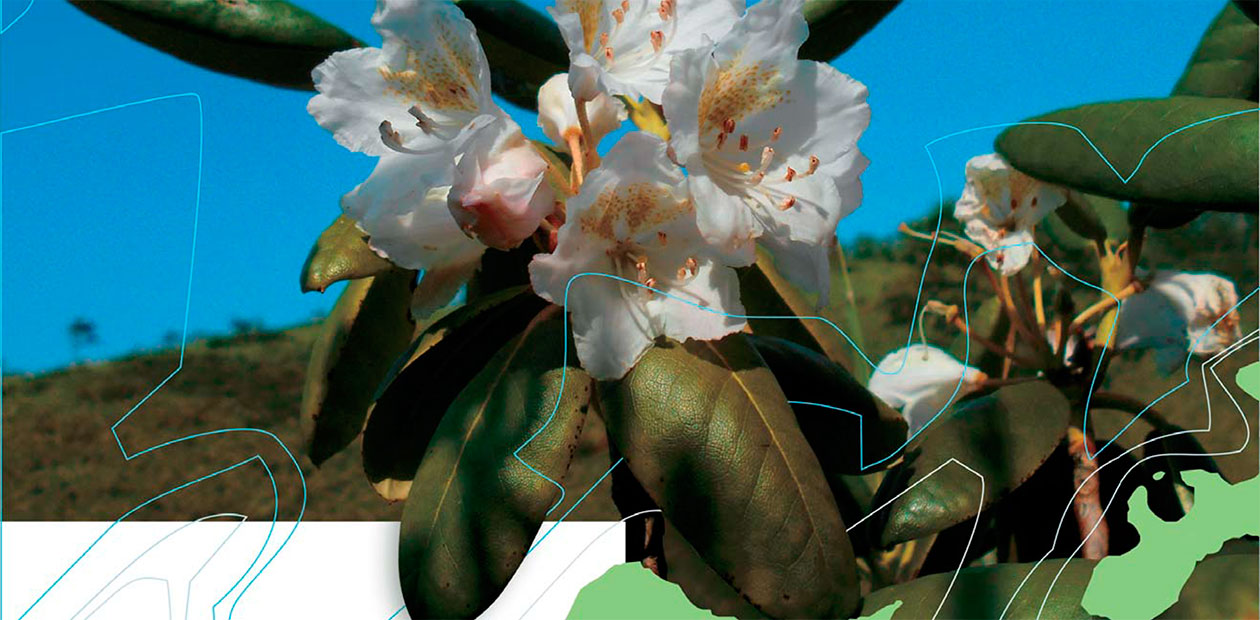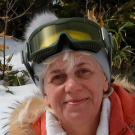The Elusive Rhododendron
The South Kurils are home to a beautiful and rare “redlisted” shrub – the short-fruited rhododendron, a real mystery plant. Scientists are still divided in their opinions on whether it is a separate species or a variety; there are ongoing discussions regarding the color of its flowers, which some claim can be pure white, pink, or purplish… A couple of these shrubs were reportedly seen on the Kunashir in the late 1980’s, in a remote, inaccessible place on the edge of the Golovin volcano caldera. This is where workers of the Kurilskiy nature reserve headed, 30 years later...
In recent decades, researchers of the southern Kuril islands of Iturup and Kunashir encountered only a handful of individual plants of the short-fruited rhododendron. However, they did not provide the exact coordinates of their finds, for apparent reasons, and the descriptions of the location were very approximate.
In March of 2017, Aleksandr Yakovlev, the staff driver, research assistant and devoted comrade in all things, and I decided to start searching for the elusive rhododendron in the Kurilskiy nature reserve and its buffer zone.
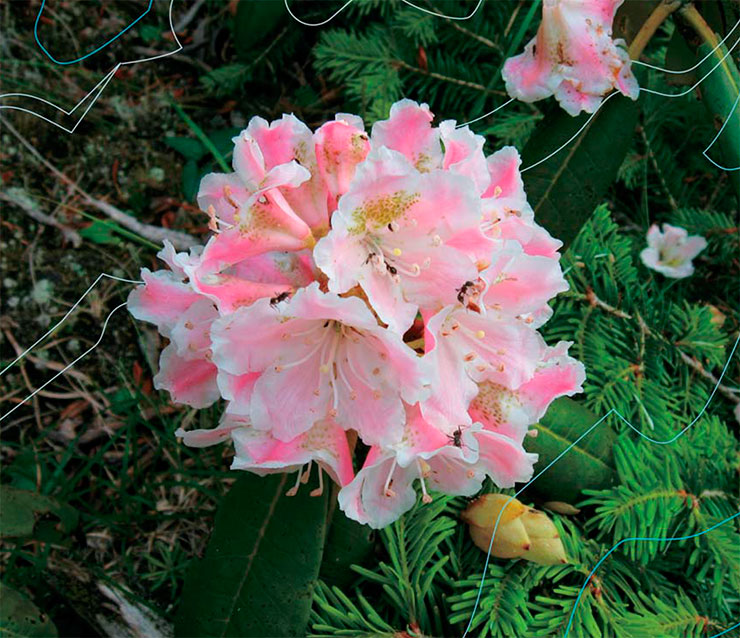
A. G. Truberg, an expert on amphibians and reptiles who worked here in the late 1980’s, informed our director through personal communication that he observed several individuals of this rhododendron near the Golovnin volcano caldera, describing the location in the following manner: “along the tiny little creek, away from the cabin, on the very ridge of the caldera”. What cabin did he mean, and where was that creek? The correspondence ceased, and we failed to learn the specifics. We knew that our destination was near the lake Goryachee, located in the northeastern part of the Golovnin volcano caldera. This was the location pointed out by the researchers who were lucky to encounter this rare plant on the Kunashir (Alekseeva, 1983).
Following fox tracks
We need to cover about 10 km separating the highway from Yuzhno-Kurilsk to Golovnino and the Ozernyi ranger station, located in the caldera. March is a full-blown winter month on the Kurils, but we can feel the breath of spring in the caldera: there are yellow catkins on the willows surrounding the cabin.
We reach the ranger station on a snowmachine. The Ozernyi station was one of the first to be built in the reserve, back in the 1980’s. The old cabin has tilted, and there is a crack in the corner, with a chilly draft sweeping across the floors…
Knowing how to operate all sorts of machinery is an indispensable skill for nature reserve workers, and especially men. One must know how to deal with an axe, firewood, and wood stove. The ranger cabin cooled instantly, and someone had to keep the fire burning all night.
The genus Rhododendron (Rhododendron), the largest genus of the Heather family (Ericaceae), includes over 1200 known species. Of the 20 species of these evergreen shrubs recorded for Russia, 13 occur in the Far East. Five species, with limited ranges and small populations, listed in the Red Books of Russia and the Sakhalin Oblast, are of special interest, including the short-fruited rhododendron (Rhododendron brachycarpum)In the morning, we had to go look for the rhododendron, regardless of how well one has slept. On that day, we were checking the version which put the shrub on the shore of the lake Goryachee. Being able to ski or use snowshoes would come in handy here. It might not seem like a very complicated skill, but without practice, it’s quite difficult.
And yet, winter is the best season to explore the interior of the island. Without the snow, it is next to impossible to move without trails: the sasa bamboo (a small, grassy, northerly bamboo species of the genus Sasa) forms a nearly impenetrable brush of sprouts. Snow, especially with a solid crust on top, presses down bamboo sprouts and dwarf Siberian pine, but it does not conceal the rhododendron: this evergreen shrub stays above the snow surface, and thanks to its peculiar leaves that roll up in winter, it cannot be mistaken for anything else.
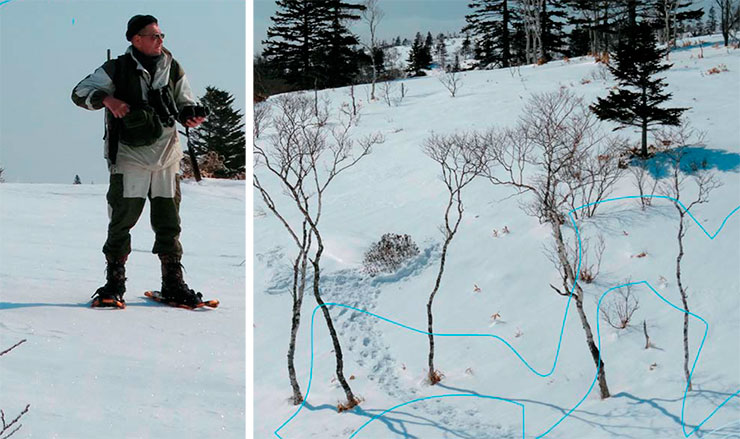
We spent the day exploring open spaces near the western shore of the lake: we went up and down with the help of our GPS units (being familiar with using these devices is a must for a nature reserve worker). We abandoned our search after accidentally coming across a bear den. We could clearly see a yellowish breathing hole in the snow about 10 meters away – a sure sign of an inhabited den. Sasha decided to turn around and go back to the ranger cabin: in the spring, bears are light sleepers, and we did not want to encounter a grumpy bear…
The next day, we continued our quest to find the rhododendron on the other side of the lake, on the norheastern slope of the caldera. We had to ascend to the ridge through the forest. The hike was easier for me because my snowshoes held me well, but Sasha was heavier and had to muddle through the tacky snow knee-deep – and walking like that is decimates your resources fast.
RHODODENDRONS: ONE OR TWO? The short-fruited rhododendron (Rhododendron brachycarpum) has a systematic “twin” – the Faurie rhododendron, or pink rhododendron. Both species were described from Japan in the late XIX century.Initially it was believed that in Russia, and only on the Southern Kurils (the Iturup and Kunashir islands), only the Faurie rhododendron with pink flowers occurs. Later, in the Primorskiy Kray, a rhododendron with while flowers was discovered on the Sikhote-Alin mountain range. In the early 1980’s, Soviet researchers declared the two rhododendrons belonging to the same species, noting that a pink-flowered form occurs in the Sakhalin Oblast, and a white-flowered form occurs in the Primorskiy Kray. However, it did not end there.
Eventually, peculiarities of leaf pubescence were added to flower coloration as a diagnostic feature, however, scientists could not reach an agreement here. For instance, T. Yamazaki (1989), a Japanese botanist, considered the lower surfaces of the short-fruited rhododendron to be ву pubescent, while in the pink rhododendron, they are “nude”.
The mess in the systematics of morphological forms of the plant continued. According to “Vascular plants of the Soviet Far East” (1991), they are two distinct species with white and pink blossoms. A later monograph on the flora of the Kurils (and in the current Russian Wikipedia) the names R. brachycarpum and R. fauriei are provided as synonyms (Barkalov, 2009).
To solve such taxonomic issues, standard morphological criteria must be amended with molecular genetic data. Combined, these data can be critical for the study of the Far Eastern flora, since they make it possible to evaluate its age and connections with floras of other parts of the world
Fortunately, the snow was less dense on the ridge. We saw thickets of the forked viburnum (Viburnum furcatum) and the Japanese alpine cherry (Prunus nipponica), but still no rhododendron… We returned to the cabin at dusk: a blizzard began, and snowmachine tracks were fading quickly. The key is to stay focused and return to the base quickly, not to be trapped out in the snow.
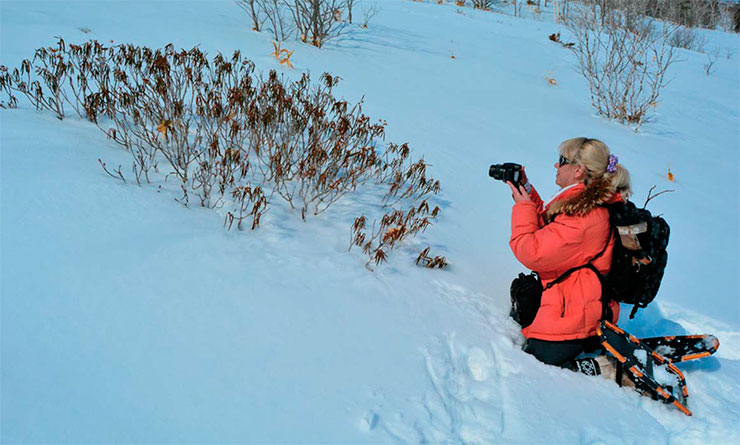
Two days in the caldera were fruitless – but we didn’t lose hope and continued our search on another possible sighting site. We picked a cold, sunny day, defined the search area and punched the coordinates of the approximate destination into our GPS units.
We loaded two snowmachines into the truck and drove to the starting point. I took snowshoes, just in case, and I was right: the snowmachines kept getting stuck in deep snow. We drove the snowmachines back to the base, put on the snowshoes and continued…
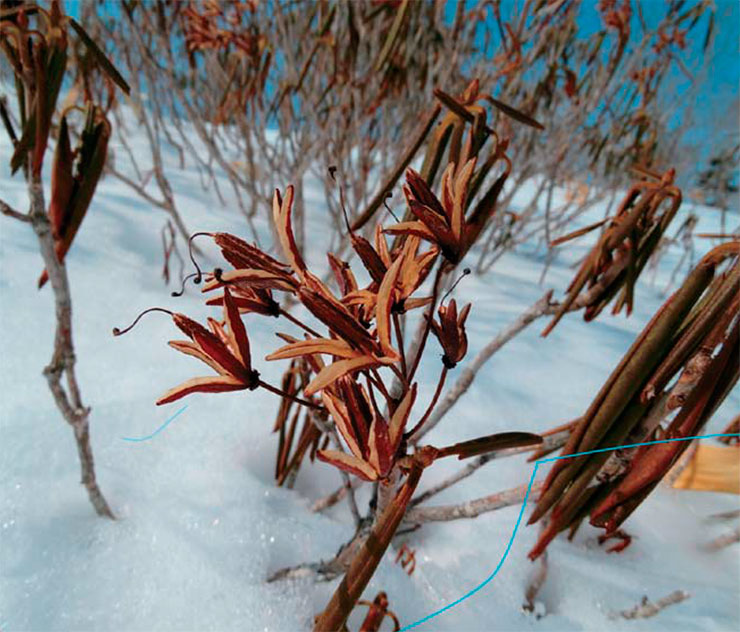
The morning crust on the snow was easy to walk on. Sasha and I walked fast, without falling through, admiring the ornamental frost on branches sparkling in the morning sun. We ascended and descended slopes several times and realized we were following a set of fox tracks. Three hours later, we reached the base of the Golovnin mountain – our assumed destination point.
…I study the surroundings through my binoculars: Siberian pine, hortensia, doghobble (Eubotryoides grayana)… all familiar but not what I’m looking for. I suggest that we return, but Sasha insists and wants to hike a couple of hundred meters more, and reach the end of the watershed ridge.
Snow has melted and doesn’t support our weight anymore, our energy is vanishing… we are following a fox trail, and Sasha, looking around through his binoculars, asks me to take a look at an unusual shrub maybe 300 meters away, in a ravine. There it is! I rush to the shrub without a word – unexpectedly reenergized. Getting closer, I yell, from the heart: “We found you!!”… We are overflowing with emotion. I kiss Sasha gratefully. He is also happy, and shows me a chain of tracks that we followed: the fox walked up to the bush, circled around it and went further uphill.
They are white after all!
…July of 2017, early morning. Aleksandr Aleksandrovich Kisleyko (we call him Sanych) decided to join us on the hike to our “new” rhododendron. Our main goal is to see the blooming plant and finally find out the color of its blossoms.
There are three of us: Sasha, Sanych, and I, and three kilometers of bamboo fields and small patches of forest ahead of us. We know it won’t be easy. It’s tolerable until lunch: just creek valleys and watershed ridges. The sun reaches zenith, and trekking becomes truly challenging.
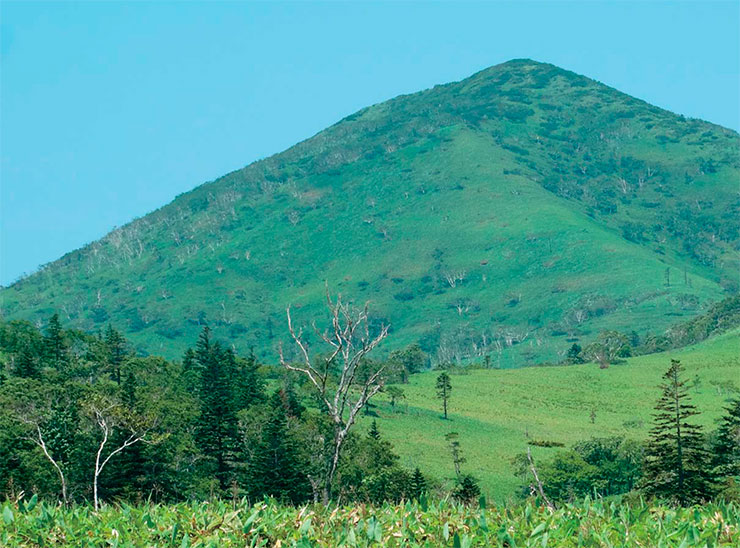
We chose the following tactics: after 50–100 meters, we rest for 10–15 minutes in the shade of a tree. Just 300 meters an hour – so slow, why? Out feet get caught in tangled sprouts of sasa bamboo (Sasa kurilensis): dense thickets of this plant hinder our movement, and you get the impression you aren’t moving at all: you step forward, fall, stand up, and move on, clenching your teeth…
The heat is unreal… I can see the guys aren’t feeling well. I joke during our stops to rest, and try to keep the spirits up. Sasha starts vomiting, his blood pressure has spiked. Sanych is feeling dizzy… There is no cell signal. I begin panicking: “The only way to get out of here is a helicopter, but we’d need connection for that!”. I suggest that we turn back, but the men are adamant – we will reach the destination!
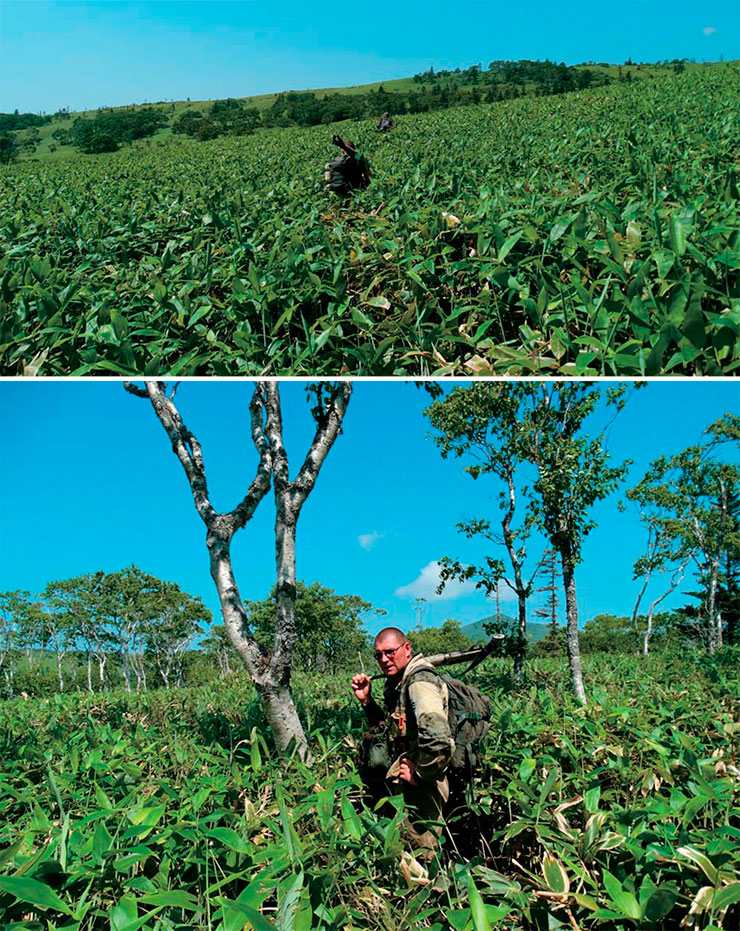
When we were about 400 meters away from our goal, it became apparent that Sasha couldn’t continue the hike. We decided to take a break, and Sanych volunteered to go further and take pictures of the blooming shrub. We decided to keep in touch through our walkie-talkies. An hour and a half later, we heard a happy voice: “I’m here! They’re white!”. Once again, we are euphoric…
To return, we walk along the Golovnin river; our rhododendron was found at its mouth. It is getting late. The surrounding area is trampled down by bears, and it smells of bear fur, and of predators… we are running on fumes, trying to reach the road before dusk.
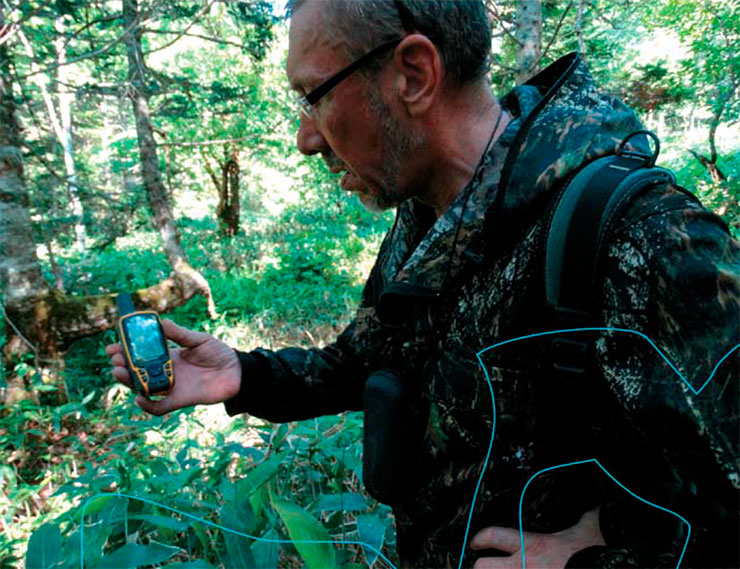
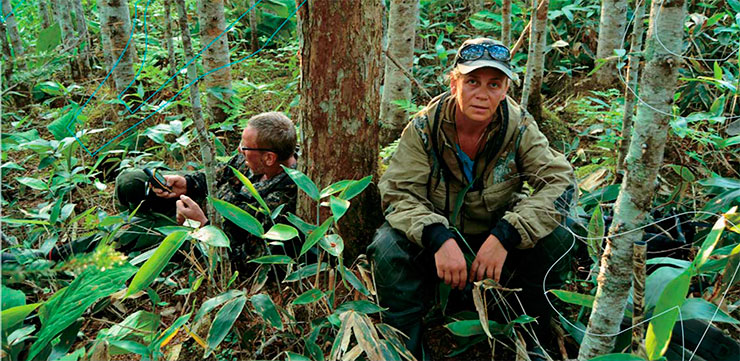
Five more hours across rough terrain. We are marking the coordinates of rare plants with Sanych as we go – we don’t know if we ever come back here. We reach our truck by 11 p. m., completely drained, but happy.
Ahead of us was the genetic analysis of our specimens, to confirm that we were really dealing with the short-fruited rhododendron. But this is a different story…
Genetics to the rescue
Before our find, it was believed that the Kurils are home to the short-fruited rhododendron (R. brachycarpum) with pink blossoms and leaves with pubescent downside. However, we discovered individuals that did have the pubescent leaves, but also had white flowers. It is known that this rhododendron is quite widespread on the Japanese islands of Hokkaido and Honshu, and the color of its blossoms is variable between populations and ranges from white to bright pink (Ohwi, 1965). However, this does not contradict the possibility of the occurrence of the white-blossomed form on the Kunashir.
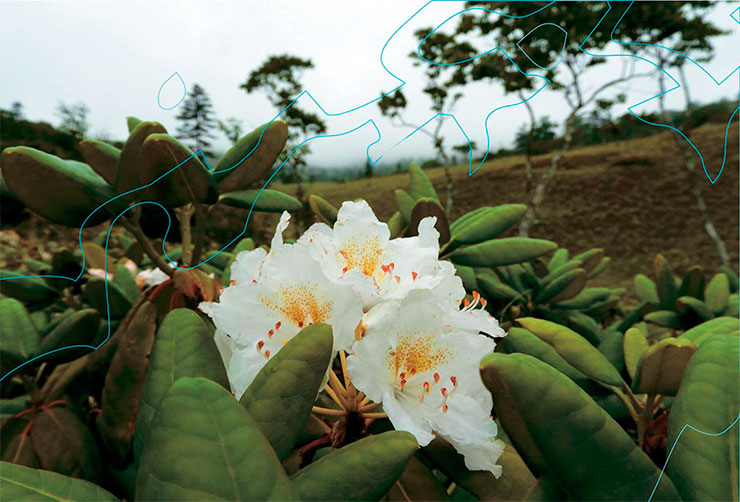
Our assumption was confirmed by the results of a comparative molecular phylogenetic analysis performed by experts of the Department of Biology of the M. V. Lomonosov Moscow State University. To build a rhododendron “pedigree”, they used a fragment of ribosomal DNA as the molecular marker, and specimens from the Kunashir were complemented with specimens from herbariums, including the Hokkaido University Museum.
Analysis has shown our white-blossomed plant to be close to samples of pink-blossomed individuals of the short-fruited rhododendron from the Honshu island. Overall, all currently available genetic and morphological data support the assumption that R. fauriei and R. brachycarpum are good separate species (Khokhryakov, Mazurenko, 1991). Of course, these conclusions are preliminary and need to be tested on a larger number of samples collected both on the islands and on the continental part of the shrubs’ range.
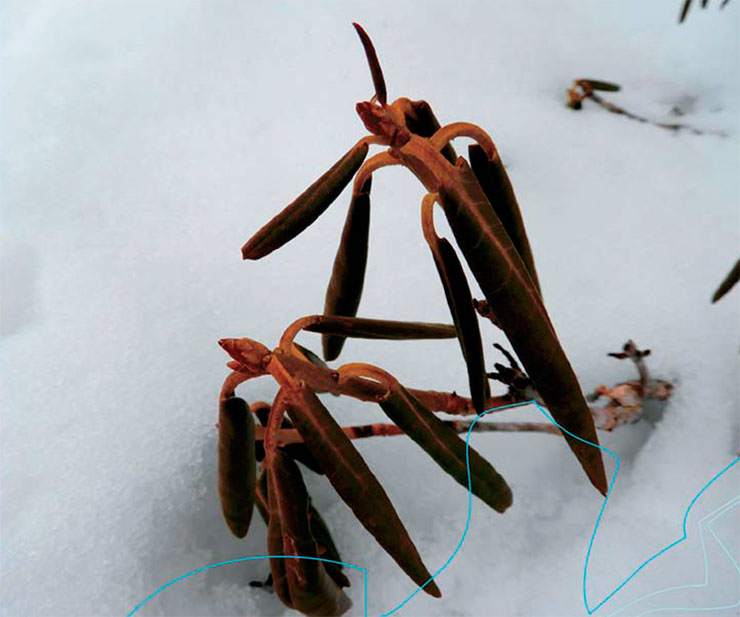
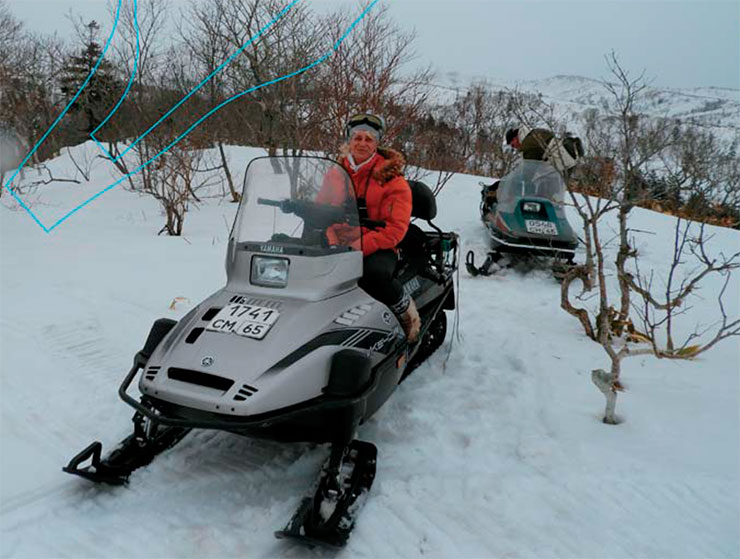
For the Kunashir, the short-fruited rhododendron is considered a rare plant. The shrub found in the upper reachers of the Golovnin river grows in the buffer area of the nature reserve and can be destroyed by military vehicles or snowmachines. This is why we kept visiting our rhododendron in the following two years, in March and July.
In 2019, a large population of R. brachycarpum with identical white flowers and characteristically pubescent leaves was discovered on the Kunashir outside the protected area, on the northern slope of the Treugol’nik mountain, 420 m (1378 ft) above sea level. Samples were sent to specialists of the Moscow State University Biology Department for genetic analysis.
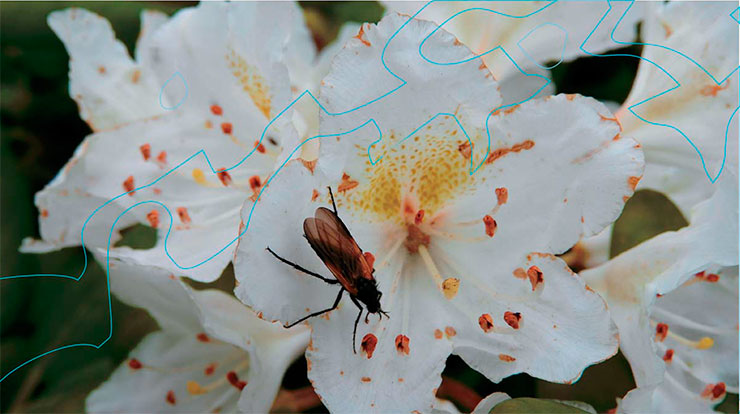
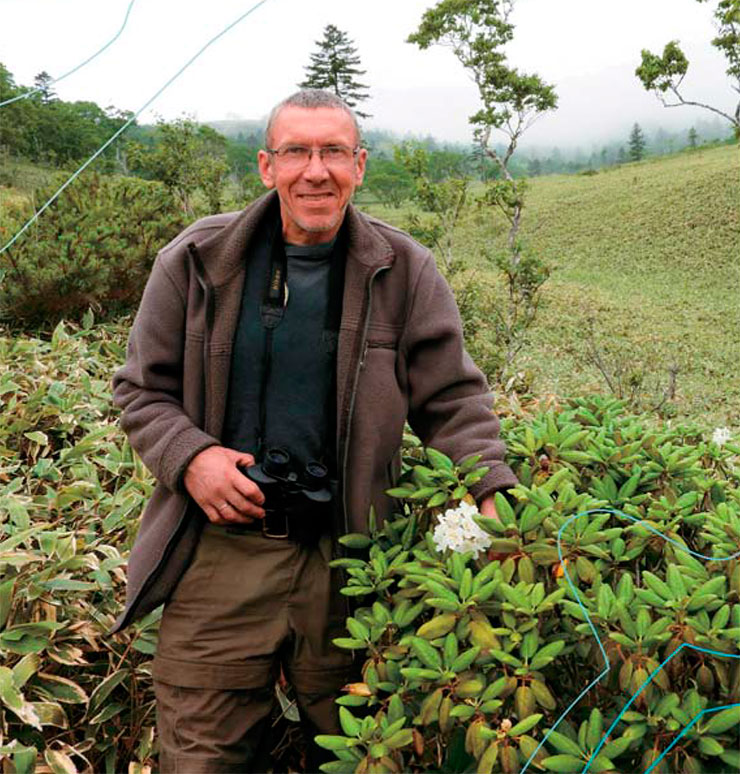
Until this find, there were plans to repopulate the island with this rare plant: growing from seeds in a nursery and planting in the wild around the maternal plants. Luckily, it has turned out that this rhododendron is not at risk of extinction on the Kunashir.
Currently, the nature reserve workers are focusing on supporting the reproduction of the rarest species, which occur only on the Kunashir and nowhere else in Russia. They include the Japanese cucumber tree (Magnolia obovata), the only member of the Magnolia family occurring in the wild in our country. Seedlings germinated from seeds of this relic tree are grown in greenhouses for several years, to be eventually planted outside the nature reserve territory. This will help save and increase the numbers of one of themultiple ornamental beauties of the Kuril forests.
References
Alekseeva L. M. Flora of the Kunashir island (plants). Vladivostok: FESC USSR AS Publishing house, 1983. 79 p. [in Russian].
Barkalov V. Yu. Flora of the Kuril Islands. Vladivostok: Dalnauka, 2009. 468 p. [in Russian].
Linnik E. V., Degtyareva G. V., Efimov S. V. et al. Preliminary results of monitoring of the short-fruited rhododendron (Rhododendron brachycarpum D. Don ex G. Don fil.) on the Kunashir Island (Sakhalin Oblast) // Problems of Botany of South Siberia and Mongolia. 2020. V. 19. N 2. P. 71–75. [in Russian].
Mazurenko M. T. Rhododendrons of the Far East, their structure and morphogenesis. Moscow: Nauka, 1980. 232 p. [in Russian].
Khokhryakov A. P., Mazurenko M. T. Ericaceae Juss // Vascular Plants of the Soviet Far East. St. Petersburg: Nauka, 1991. V. 5. P. 119–166. [in Russian].
The «Kurilskiy» Nature Reserve: at the crossroads of three elements // Science First Hand. 2021. N. 3 (59). P. 54–71.


